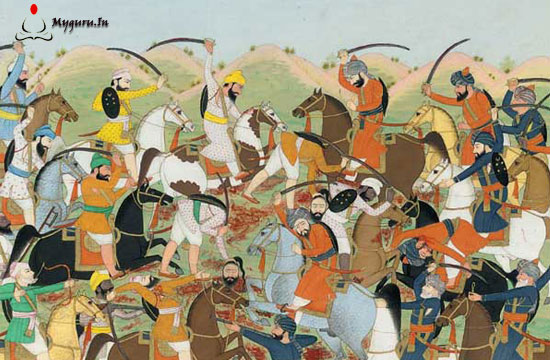Chali Mukte
The Forty Liberated Ones (Chaali Mukte):
A Testament to Devotion and Sacrifice
The history of the Sikh faith is replete with tales of courage, sacrifice, and unwavering devotion. Among these, the story of the “Chaali Mukte” (Forty Liberated Ones) during the time of Sri Guru Gobind Singh Ji stands as a beacon of resilience and spiritual triumph. This episode, rooted in the 18th century, exemplifies the profound bond between a Guru and his disciples and the transformative power of faith.
The Context:
The Siege of Anandpur Sahib
During the late 17th and early 18th centuries, the Sikh community faced relentless persecution from the Mughal Empire and its allies. Guru Gobind Singh Ji, the tenth Sikh Guru, established the Khalsa in 1699 to protect the oppressed and uphold righteousness. This declaration of sovereignty and equality posed a direct challenge to the oppressive regimes, leading to repeated conflicts.
In 1704, Anandpur Sahib, the spiritual and military stronghold of the Sikhs, was under siege by Mughal forces and their hill chieftain allies. The prolonged blockade caused immense hardship, with dwindling food supplies and growing discontent among the defenders.
The Departure of the Forty Sikhs
Amidst this adversity, a group of forty Sikhs, led by Bhai Mahan Singh, approached Guru Gobind Singh Ji with a written declaration (“Bedawa”) renouncing their allegiance and seeking permission to leave the fort. Understanding their plight but respecting their free will, Guru Ji allowed them to depart. This act, however, was a significant spiritual and emotional moment, as it tested the resolve and faith of the disciples.
The Battle of Muktsar
The group of forty Sikhs returned to their homes in Majha, but their conscience weighed heavily on them. When they learned that Guru Gobind Singh Ji was being pursued by Mughal forces, their dormant sense of duty and devotion reignited. Inspired by the relentless faith of Mai Bhago, a devout Sikh woman, they resolved to atone for their earlier decision by defending their Guru.
The group reassembled and intercepted the Mughal forces near Khidrana (present-day Muktsar) in 1705. Despite being vastly outnumbered, the Sikhs fought valiantly, sacrificing their lives to halt the advancing enemy. Their courage and selflessness provided Guru Gobind Singh Ji enough time to retreat to safety.
Redemption and Liberation
After the battle, Guru Gobind Singh Ji discovered the lifeless bodies of his loyal Sikhs. Among them was Bhai Mahan Singh, who, with his dying breath, sought forgiveness for their earlier abandonment. Guru Ji, moved by their sacrifice, declared them “Mukti” (liberated) and immortalized their memory as the “Chaali Mukte.”
Legacy and Significance
The story of the Forty Liberated Ones transcends its historical context, offering profound lessons in redemption, duty, and devotion. It underscores the Sikh ideals of courage and humility, reminding followers that even those who falter can find redemption through faith and action.
The site of their martyrdom, Muktsar Sahib, became a place of pilgrimage and reflection. The annual celebration of “Maghi Mela” at this location honors their sacrifice and reinforces the spiritual bond between Guru and disciple.
Conclusion
The tale of the Chaali Mukte is not merely a historical account but a timeless narrative of the human spirit’s resilience and the transformative power of faith. It serves as an enduring source of inspiration for Sikhs and all those who value courage, redemption, and selfless service. Through their sacrifice, the Forty Liberated Ones etched their names into the annals of Sikh history, leaving a legacy that continues to inspire generations.
40 Mukta
1. Bhai Bhag Singh ji
2. Bhai Dilbagh Singh ji
3. Bhai Man Singh ji
4. Bhai Nidhan Singh ji
5. Bhai Kharbara Singh ji
6. Bhai Darbara Singh ji
7. Bhai Dayal Singh ji
8. Bhai Nihal Singh ji
9. Bhai Kushal Singh ji
10. Bhai Ganda Singh ji
11. Bhai Ishmer Singh ji
12. Bhai Sindha Singh ji
13. Bhai Bhalla Singh ji
14. Bhai suhail Singh ji
15. Bhai Chamba Singh ji
16. Bhai Ganga Singh ji
17. Bhai Sumer Singh ji
18. Bhai Sultan Singh ji
19. Bhai Maya Singh ji
20. Bhai Masa Singh ji
21. Bhai Sarja Singh ji
22. Bhai Sadhu Singh ji
23. Bhai Gulab Singh ji
24. Bhai Harsa Singh ji
25. Bhai Sangat Singh ji
26. Bhai Hari Singh ji
27. Bhai Dhanna Singh ji
28. Bhai Karam Singh ji
29. Bhai Kirat Singh ji
30. Bhai Lachman Singh ji
31. Bhai Buddha Singh ji
32. Bhai Kesho Singh ji
33. Bhai Jado Singh ji
34. Bhai Shobha Singh ji
35. Bhai Bhanga Singh ji
36. Bhai Jado Singh ji
37. Bhai Dharam Singh ji
38. Bhai Karam Singh ji
39. Bhai Kala Singh ji
40. Bhai Maha Singh ji

